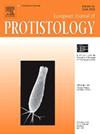藻类有机质改变了海岸沉积物中原生生物群落结构和组装过程。
IF 1.6
2区 生物学
Q4 MICROBIOLOGY
引用次数: 0
摘要
硅藻华是一种全球性的生态扰动,释放藻类有机物(AOM),通过改变微生物群落动态显著影响沿海生态系统。AOM来源于藻类细胞裂解,可能是影响原生生物群落的营养源。然而,在沿海沉积物中,AOM对原生生物生态的影响,包括群落结构和组装过程,在很大程度上仍未被探索。在这项研究中,我们利用大基因组分析和高通量测序研究了AOM对原生生物群落结构的影响。结果表明,原生物多样性(α和β多样性)和群落组成发生了显著变化。光养生物和消耗生物是受影响的主要功能群,其相对丰度受AOM的显著调控,突出了其功能水平的影响。此外,AOM还影响了原生生物群落的聚集,增加了确定性过程的比例,改变了原生生物共现网络的动态演替。硅藻华作为生态过滤器,减少多样性,同时促进特定功能群的优势。这项研究填补了理解AOM在塑造沿海沉积物中原生生物生态演替中的作用的空白,为海洋硅藻华更广泛的生态影响提供了有价值的见解。本文章由计算机程序翻译,如有差异,请以英文原文为准。

Algal organic matter alters protistan community structure and assembly processes in coastal sediments
Diatom blooms are a global ecological perturbation that releases algal organic matter (AOM), significantly affecting coastal ecosystems by altering microbial community dynamics. AOM, derived from algal cell lysis, may serve as a nutrient source influencing protistan communities. However, the effects of AOM on protistan ecology, including the community structure and assembly processes, remain largely unexplored in coastal sediments. In this study, we investigated the impact of AOM on the protistan community structure using macrogenomic analysis and high-throughput sequencing. The results revealed significant shifts in the protistan diversity (alpha and beta diversity) and community composition. Phototrophs and consumers were the primary functional groups affected, with their relative abundances significantly regulated by AOM, highlighting its functional-level impacts. Moreover, AOM influenced also the protistan community assembly, increasing the proportion of deterministic processes and altering the dynamic succession within the protistan co-occurrence network. Diatom blooms act as ecological filters, reducing diversity while promoting the dominance of specific functional groups. This study bridges the gap in understanding the AOM's role in shaping the ecological succession of protists in coastal sediments, offering valuable insights into the broader ecological impact of marine diatom blooms.
求助全文
通过发布文献求助,成功后即可免费获取论文全文。
去求助
来源期刊

European journal of protistology
生物-微生物学
CiteScore
4.60
自引率
20.70%
发文量
55
审稿时长
14.6 weeks
期刊介绍:
Articles deal with protists, unicellular organisms encountered free-living in various habitats or as parasites or used in basic research or applications. The European Journal of Protistology covers topics such as the structure and systematics of protists, their development, ecology, molecular biology and physiology. Beside publishing original articles the journal offers a forum for announcing scientific meetings. Reviews of recently published books are included as well. With its diversity of topics, the European Journal of Protistology is an essential source of information for every active protistologist and for biologists of various fields.
 求助内容:
求助内容: 应助结果提醒方式:
应助结果提醒方式:


